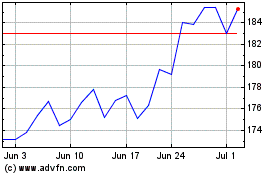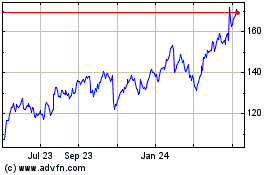Europe's New Idea: Taxing User-Generated Profit
March 21 2018 - 11:37AM
Dow Jones News
By Paul Hannon
LONDON -- The European Union's justification for a new tax on
technology companies hinges on a novel view of how profits are
generated that the U.K. Treasury presented in November.
Traditionally, the profits of a company operating
internationally have been taxed where its major decisions are made
and its most important assets are controlled. In practice, those
taxes have often been levied in countries where the company also
has a large number of customers. But the location of user of its
product or service hasn't been decisive.
The European Commission, the EU's executive arm, on Wednesday
proposed a tax set at 3% of revenues on some of the digital
activities of a small cadre of tech superpowers, including Facebook
Inc. and Alphabet Inc.'s Google.
European officials say that digital products rely increasingly
on crunching millions' of users data to generate value -- for
example, by targeting niche ads directly at users, or by combining
millions of interactions to improve an app's voice-recognition
capabilities. European officials say that means value is generated
where users are located -- and the system should change so tax
should be paid there, too.
That is a radical departure from the principles that have guided
international business taxation to date, and incorporates a logic
advanced in November by the U.K. Treasury. In a "position paper"
setting out the potential arguments for a tax on digital companies,
Treasury officials argued that "for many digital businesses that
operate in markets through an online platform, the users of the
platform...create material value for a business through their
sustained engagement and active participation."
"That is a brand new principle," said Will Morris, deputy global
tax policy leader at business services firm PwC.
The view that users do help create value under some business
models isn't shared outside Europe. In a report that highlighted
the lack of agreement between governments on how to tax digital
businesses, the Organization for Economic Cooperation and
Development Friday said there are "differences of opinion" on the
question.
Instead, tax authorities such as those of the U.S. argue that
digital businesses compensate users for the data they extract from
them through the provision of services such as data hosting, email
and entertainment. In other words, there is a digital barter
economy, and the only things that should be taxed are the services
provided to users, but as a form of income.
The difference of opinion over the role of users overlays a more
fundamental split between Europe and the U.S. Europeans argue that
some highly digitalized businesses are fundamentally different and
should be targeted through special taxes. The U.S. is against taxes
that single out digital businesses, and instead believes a broader
overhaul of the international tax system is needed to respond to
the digitization of business in general.
For now, the world's largest economies intend to try to work out
their differences.
"The impacts of the digitalisation of the economy on the
international tax system remain key outstanding issues," finance
ministers from the Group of 20 largest economies said in a
statement Tuesday. "We are committed to work together to seek a
consensus-based solution by 2020, with an update in 2019."
But Mr. Mills, who helps represent the view of business in OECD
deliberations on policy, said the Commission's adoption of a
controversial new principle may make that more difficult to
achieve.
"There is the danger that people who disagree with it will walk
away," he said. "And for those countries that adopt these measures,
it eases the political pressure to engage in a difficult
conversation."
Write to Paul Hannon at paul.hannon@wsj.com
(END) Dow Jones Newswires
March 21, 2018 11:22 ET (15:22 GMT)
Copyright (c) 2018 Dow Jones & Company, Inc.
Alphabet (NASDAQ:GOOGL)
Historical Stock Chart
From Mar 2024 to Apr 2024

Alphabet (NASDAQ:GOOGL)
Historical Stock Chart
From Apr 2023 to Apr 2024
